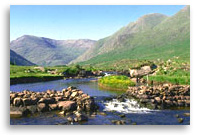 |
Galway City, known as the City of the Tribes with its
seaside suburb of Salthill, is an important tourist centre
and a gateway to the scenic areas of the county.
In the 1400s, there began in Galway the rule of the
'Tribes', as the leading fourteen families were called.
Their names were Athy, Blake, Bodkin, Browne, D'arcy, Deane,
ffont, French, Joyce, Kirwan, Lynch, Martin, Morris, and
Skerritt.
More |
|
Geographical Features
Towns: The main centre of population
is Galway City, with the other main towns being Athenry,
Ballinasloe, Clifden, Gort, Loughrea and Tuam. See full
list of Towns in
Galway.
Mountain Ranges: The Twelve Bens dominate the skyline of
South Connemara, with the Maamturks being the main
mountain range to the North. See
Mountains in Galway
Islands: The coastline is dotted with islands with the
Aran
Islands being the main attraction.
Other inhabited islands include
Inishbofin and
Inishturk.
Lakes / Rivers: County Galway has several freshwater
lakes,
with trout, salmon and coarse fishing being the main
attraction. The largest lake is
Lough Corrib
Beaches: County Galway has several blue flag
beaches.
The largest beaches are found in the Roundstone and
Renvyle areas.
Festivals: Galway is also famous for its many festivals,
including the
Galway Races,
Galway Arts Festival and the
Clarinbridge Oyster Festival. Click for
Festivals in Galway.
Gift Vouchers in Galway
Main Tourist
Attractions
Athenry – Mediaval Town with
Arts and Heritage Centre
Athenry, a medieval
town situated 23km from Galway City is steeped in history.
Founded in the 13th century by Meiler de Birmingham, who
surrounded the town with a curtain wall with towers and a
moat. It is the only walled town in Ireland whose still-intact
walls are clearly visible to the approaching
visitor.
Battle of
Aughrim Interpretative Centre
Aughrim,
Ballinasloe - on the main Galway – Dublin Road.
Relive the
bloodiest battle in Irish history fought in a small Connaught
village. Move back in time and place to that fateful day in
1691 through an audio-visual show based on the moving account
of Captain Walter Dalton who fought at the Battle of
Aughrim.
St. Jarlath's Wheel - Tuam
Located beside the Catholic Cathedral in
the North Galway town of Tuam.
Tuam is also home to a
13th century parish church ruins and graveyard,
located at Teampall Jarlath, High St. Tuam.
Galway
Bay
Drive along the coast road from Galway to
Spiddal and view the splendour of Galway Bay. Later in the day
one can experience the famed in song ‘Sun go down on Galway
Bay’
Continuing West takes one into the Twelve Pins
of Connemara mountain range.
Tropical
Butterfly Centre
Carraroe, Connemara,
Galway. 2 miles from Rossaveal Harbour on R343. Located in the
heart of Connemara, Seawinds Nurseries and Tropical Butterfly
Centre offers a unique experience in family entertainment,
regardless of weather. Set amid the lush splendour of a
tropical enclosure, you can see hundreds of free flying exotic
Butterflies in their natural environment.
The Aran
Islands – located in Galway Bay
Situated at
the mouth of Galway bay. Day trips available from Galway and
Clare coasts. Organised tours available on the Islands. Visit
the cottage where J.M. Synge, the well-known Anglo-Irish
author and playwright stayed and took the theme of The Playboy
of the Western World.
Eyre Square – Galway
City
Eyre Square (renamed John F Kennedy Park) ; an
open green park where on can relax or view the many
attractions, including the Statue of Paraic O’Connaire ;
erected in 1935 in memory of the writer who travelled the
roads with his horse and cart. Best remembered for M’asal Beag
Dubh. Died 1928
Kirwan's Lane - Galway City
Kirwan's Lane (off Quay Street) is one of
Galway's last remaining late Mediaeval Lanes and has been
recently redeveloped as a residential area. It was here that
the Galway MP Richard Martin built a 100-seater theatre for
his actress wife in 1783. Among those who acted there was the
republican patriot, Wolfe Tone.
Clifden in West
Galway
The location of the landing of the first
Trans-Atlantic air crossing by Alcock and Brown. A very scenic
part of Ireland.
Kinvara –
Galway Hooker Boats
Kinvara hosts an annual
festival to celebrate those unique sea boats each year. Always
a selection of the old style Hooker boats on view. Those boats
were used to transport turf in bygone days.
Portumna Castle
The great
semi-fortifed house at Portumna was built before 1618 by
Richard Burke or de Burgo, 4th Earl of Clanricarde. There are
exhibitions in the castle and Gate House.
Coole
Park
Located close to Gort, on the Galway Road,
the former home of Lady Gregory, a founder of the Abbey
Theatre and friend of William Butler Yeats. The house no
longer stands, but the estate is now a national nature
reserve. The garden of the house, with its yew walk and
autograph tree is preserved. Carved on the autograph tree,
among others are the signatures of John Masefield, George
Bernard Shaw and Sean O'Casey. Attractions include nature
trails, walks, a lake and turlough.
Thoor Ballylee
Once the former
summer home of W.B. Yeats this restored Norman tower house was
purchased by Yeats in 1916. In 1965 the tower was opened to
the public. An audio visual presentation and push button audio
narratives in the rooms are available in the tower, which is
open to the public from Easter to October.
Turoe Pet Farm
Located close to
Loughrea, in a beautiful rural setting, Turoe Pet Farm
provides great attractions for young and old, native and
tourist! Excellent facilities are provided catering for
individual, family and group needs.
Dunguaire
Castle
Located in Kinvara, Dunguaire Castle was
built by the O'Hynes in 1520. The clans association with the
castle dates back as far as 662AD when their ancestor Guaire,
King of Connnacht, ruled his kingdom from an earthwork rath
close to the present castle site. Richhad Martyn, Mayor of
Galway, acquired the castle in the seventeenth century and it
was subsequently purchased by Oliver Saint John Gogarty.
During his tenure the castle was the venue for meetings of the
literary revivalists, led by W.B Yeats. The bardic tradition
which Yeats believed in, is reflected in the Medieval Banquet
held every night.
Mill Museum -
Tuam
Located in Tuam, this is the last surviving
corn mill in the Tuam area. It closed as a working mill in
1964 - its machinery is still in place.
This mill played a vital
part in the life of the local community and a voluntary
committee opened it as a museum in 1974. It also serves as a
seasonal tourist information office.
Quiet Man Film Locations
County Galway
has several locations which were used in the making of the
file. The Quiet Man. Visit the main film locations in an
organised tour or join the Quiet Man Fan Club.
Heritage Sites
Athenry
Castle
Athenry is one of the most notable
medieval walled towns surviving in Ireland, owing its
foundation to Meiler de Bermingham who built his Castle there
c.1250. The great three-storey tower, surrounded by defensive
walls, is entered at first-floor level through an unusual
decorated doorway. Recently re-roofed, the interior contains
an audio visual room and exhibition.
Aughnanure Castle
Galway - Oughterard
Built by the O’Flahertys c.
1500, Aughnanure Castle lies in picturesque surroundings close
to the shores of Lough Corrib. Standing on what is virtually a
rocky island, the Castle is a particularly well-preserved
example of an Irish tower house. In addition, visitors will
find the remains of a banqueting hall, a watch tower, an
unusual double bawn and bastions and a dry harbour.
Dun Aonghasa -
Inishmore, Aran Islands
Perched spectacularly on
a cliff overlooking the Atlantic ocean, this is the largest of
the prehistoric stone forts of the Aran Islands. It is
enclosed by three massive dry-stone walls and a
"chevaux-de-frise" consisting of tall blocks of limestone set
vertically into the ground to deter attackers. The fort is
about 900m from the Visitor Centre and is approached over
rising ground.
Teach an
Phiarsaigh (Patrick Pearse's Cottage) Rosmuc
A
small restored cottage used by Patrick Pearse (1879 – 1916)
leader of the 1916 Rising, as a summer residence. The
interior, although burned during the War of Independence, has
been reconstructed and contains an exhibition and a number of
momentoes of Pearse. |








